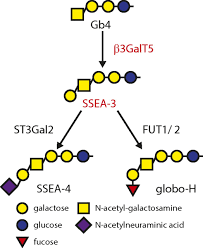All products and services are For Research Use Only and CANNOT be used in the treatment or diagnosis of disease.
SSEA-4 is epitopes on related glycosphingolipids (GSLs), termed GL-7. The GSLs of globo-series feature a Galα1–4Gal linkage to lactosylceramides, and this linkage is catalyzed by the lactosylceramide 4-alpha-galactosyltransferase, encoded by the A4GALT gene. "stage-specific embryonic antigen-4" (SSEA-4) is cell-surface marker widely used to define human embryonic stem cells (hESCs). GSLs also have been observed in tumors: SSEA-4 is expressed not only on breast cancer cells but also on breast cancer stem cells. high-level expression of SSEA-4 is observed in renal cell carcinoma.
 Associated Disease
Associated Disease
 Loading...
Loading...
| CAT | Product Name | Target Species | Antibody Clone | Antibody Host | Receptor Construction | Vector Type | Targeting Cell Type | CAR Vector Type | Inquiry & Datasheet |
| CAR-LC001 | Anti-SSEA4 h(41BB-CD3ζ) CAR, pCDCAR1 | Human | Mouse | scFv-41BB-CD3ζ | Lentiviral | T cell |
 NEWSLETTER
NEWSLETTER
The latest newsletter to introduce the latest breaking information, our site updates, field and other scientific news, important events, and insights from industry leaders
LEARN MORE NEWSLETTER NEW SOLUTION
NEW SOLUTION
CellRapeutics™ In Vivo Cell Engineering: One-stop in vivo T/B/NK cell and macrophage engineering services covering vectors construction to function verification.
LEARN MORE SOLUTION NOVEL TECHNOLOGY
NOVEL TECHNOLOGY
Silence™ CAR-T Cell: A novel platform to enhance CAR-T cell immunotherapy by combining RNAi technology to suppress genes that may impede CAR functionality.
LEARN MORE NOVEL TECHNOLOGY NEW SOLUTION
NEW SOLUTION
Canine CAR-T Therapy Development: From early target discovery, CAR design and construction, cell culture, and transfection, to in vitro and in vivo function validation.
LEARN MORE SOLUTION